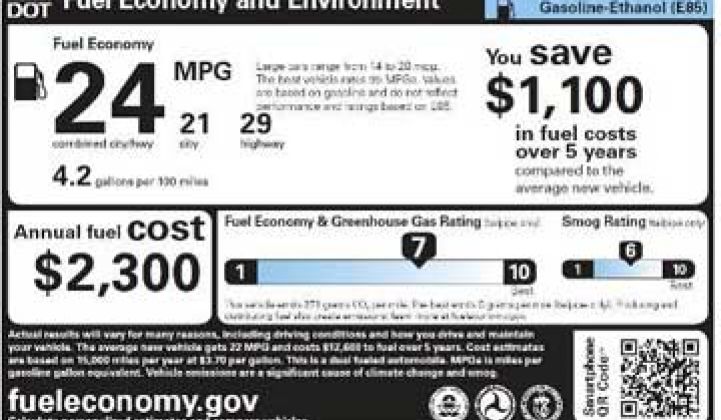Miles per gallon doesn’t make a whole lot of sense as a metric for a car that doesn’t run on liquid fuel. To correct for the new auto landscape, the U.S. Environmental Protection Agency and Department of Transportation have just announced updated fuel economy labels for the 2013 model year and beyond.
The new labels still feature MPG, but are broken into three categories: gasoline, plug-in hybrids and electric vehicles. In addition to a combined highway/city MPG or MPGe (miles per gallon equivalent), the sticker also shows gallons per 100 miles, fuel economy and greenhouse gas ratings on a scale of one to 10, smog ratings on the same scale, and fuel costs. For PHEVs and EVs, the new label gives information on charging time and range.
“This is the most significant redesign of the fuel economy label in 30 years,” said Lisa Jackson, Administrator for the EPA. “It's a chance for the American driver to spend less money and prevent pollution."
It's not just a redesign; the stickers have also entered the 21st century. Every label has a smartphone QR code for comparison shopping and even more detailed information. For buyers who don’t have a smartphone, there is a new website, www.fueleconomy.gov, where they can enter in more detailed information about the current price of gas, or the local prices of electricity for even more accurate comparisons.
If it sounds like a lot of information, it’s not. The label is still easy to read, and the added metrics, especially what people can expect to save over five years on fuel, should help clarify long-term costs. “Even I can read it,” said Ray LaHood, Secretary for the U.S. Department of Transportation. “This is about as customer-friendly as I think most people have ever seen.”
The new information will help to qualify the advantages of alternative vehicles for Americans who are interested in hybrids or electric cars, but need more information.
In a recent survey by Consumer Reports, 73 percent of nearly 1,800 adult car owners said they were considering an alternative power train vehicle, according to Jim Guest, the President and CEO of Consumers Union, which produces Consumer Reports. Two-thirds of those respondents also said they planned on buying something with better fuel economy than their current car and 60 percent also said they’d be willing to pay more. “This is a lot better than the original label” as a means of helping car buyers make educated decisions, said Guest.
It’s so good that California will be using this label rather than their own label, according to Jackson. However, that’s surely in part because California’s current label helped inform the federal version. Automakers can choose to adopt the labels as early as the 2012 model year.
In case the new fuel economy sticker wasn’t enough good news for electric and hybrid cars, President Obama also released a Memorandum on Tuesday to move the federal government’s fleet of light duty vehicles toward 100 percent alternative fuel vehicles by 2015. 'Alternative' here includes hybrid, electric, compressed natural gas or biofuels.
The federal government runs the nation's largest fleet with more than 600,000 vehicles.
The announcement also called for smaller vehicles for executive fleets for the various agencies, “except where larger sedans are essential to the agency mission.” Besides reducing the size of the cars themselves, the White House is also looking to reduce the number of cars in the fleet by providing agencies with information to help them optimize they type and size of their car inventory.
The General Services Administration will also purchase 116 electric vehicles (101 will be Chevy Volts) as part of a pilot project in Washington Detroit, Los Angeles, Sand Diego and San Francisco.
Last November, General Electric said it would purchase 25,000 electric cars for its fleet in coming years, with an initial purchase of 12,000 in 2011. At the time, Greentech Media noted that it was the largest purchase of EVs for a fleet so far, but the move by the White House dwarfs this announcement.
Although Volts and Leafs are already in the driveways of individual consumers, fleets continue to be one of the most important means by which EVs will become mainstream. Nearly half of the cars sold are actually fleet cars, said Brandon Mason, Global Powertrain Lead Analyst, U.S. Auto Practice, PricewaterhouseCoopers at The Networked EV. Government workers aren’t road tripping with the cars, and so the routes are generally well worn, and therefore range anxiety is not as much of an issue with fleets. Also, charging stations can be localized. The GSA is already planning on putting charging stations in federal buildings in the cities that were chosen for the EV pilot.
The news doesn’t stop there. Jackson said to keep an eye out for new fuel standards for heavy-duty trucks in July, and the government is also mulling more stringent fuel economy standards for cars after 2017. “My advice is stay tuned,” said Secretary LaHood.



